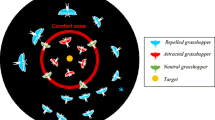Abstract
Accurately, forecasting of the flatness plays a highly significant role in the flatness theory and flatness control system, but it is quite difficult and complicated due to the nonlinear characteristics of flatness pattern recognition and lack of available observed data set. Recently, support vector regression (SVR) is being proved an effective machine learning technique for solving nonlinear regression problem with small sample set, because of its nonlinear mapping capabilities. However, it has also been proved that the prediction precision of SVR is highly dependent of SVR parameters, which are hardly choosing for the SVR. As in many excellent algorithms, gravitational search algorithm (GSA) not only has strong global searching capability, but also is very easy to implement. In the paper, an improved gravitational search algorithm (IGSA) is presented to further enhance optimal performance of GSA, and it is employed to serve as a method for pre-selecting SVR parameters. Based on SVR and IGSA algorithms, a forecasting model of flatness pattern recognition is proposed. Where, the IGSA is employed to optimize the parameters of SVR model to determine the parameters as fast and accurate as possible. Afterward, a procedure of forecasting flatness was put forward to evaluate the efficiency of the proposed IGSA–SVR model, which was compared with normal SVR model, IGSA–BP model and extreme learning machine model. The results affirm that the proposed algorithm outperforms other technique.








Similar content being viewed by others
References
Wang HF, Wu KY (2004) Hybrid genetic algorithm for optimization problems with permutation property. Comput Oper Res 31:2453–2471
Huang CF (2012) A hybrid stock selection model using genetic algorithms and support vector regression. Appl Soft Comput 12(2):807–818
Dorigo M, Maniezzo V, Colorni A (1996) The ant system: optimization by a colony of cooperating agents. IEEE Trans Syst Man Cybern B 26:29–41
Kennedy J, Eberhart RC (1995) Particle swarm optimization. In: Proceedings of IEEE international conference on neural networks, vol 4, pp 1942–1948
Karaboga D, Basturk B (2007) A powerful and efficient algorithm for numerical function optimization: artificial bee colony (ABC) algorithm. J Glob Optim 39:459–471
Kim DH, Abraham A, Cho JH (2007) A hybrid genetic algorithm and bacterial foraging approach for global optimization. Inf Sci 177:3918–3937
Rashedi E, Nezamabadi-Pour H, Saeid S (2009) GSA: a gravitational search algorithm. Inf Sci 179:32–48
Shaw B, Mukherjee V, Ghoshal SP (2012) A novel opposition-based gravitational search algorithm for combined economic and emission dispatch problems of power systems. Electr Power Energy Syst 35:21–33
Yone-gi HUR, Young-kid CHOI (2011) A fuzzy shape control method for stainless steel strip on Sendzimir rolling mill. J Iron Steel Res Int 18:17–23
Zhang H, Quan Y (2001) Modeling, identification, and control of a class of nonlinear systems. IEEE Trans Fuzzy Syst 9(2):349–354
Peng Y, Liu H, Du R (2008) A neural network-based shape control system for cold rolling operations. J Mater Process Technol 202:54–60
Liu H, Zhang X, Wang Y (2005) Transfer matrix method of flatness control for strip mills. J Mater Process Technol 166:237–242
Zhang H, Cai L, Bien Z (2000) A fuzzy basis function vector-based multivariable adaptive controller for nonlinear systems. IEEE Trans Syst Man Cybern B Cybern 30(1):210–217
Zhang H, Liu D, Luo Y, Wang D (2013) Adaptive dynamic programming for control-algorithms and stability. Springer, London
Jia C, Shan X (2008) Fuzzy neural model for flatness pattern recognition. J Iron Steel Res Int 15:33–38
Peng X (2011) TPMSVM: a novel twin parametric-margin support vector machine for pattern recognition. Pattern Recogn 44:2678–2692
Meng Q, Ma X, Zhou Y (2014) Forecasting of coal seam gas content by using support vector regression based on particle swarm optimization. J Nat Gas Sci Eng 21:71–78
Niu P, Zhang W (2012) Model of turbine optimal initial pressure under off-design operation based on SVR and GA. Neurocomputing 78:64–71
Yeh CY, Huang C-W, Lee S-J (2011) A multiple-kernel support vector regression approach for stock market price forecasting. Expert Syst Appl 38:2177–2186
Kavousi-Fard A, Samet H, Marzbani F (2014) A new hybrid modified firefly algorithm and support vector regression model for accurate short term load forecasting. Expert Syst Appl 41(13):6047–6056
Li G, Niu P, Zhang W, Zhang Y (2012) Control of discrete chaotic systems based on echo state network modeling with an adaptive noise canceler. Knowl Based Syst 35:35–40
Juhos I, Makra L, Tóth B (2008) Forecasting of traffic origin NO and NO2 concentrations by support vector machines and neural networks using principal component analysis. Simul Model Pract Theory 16:1488–1502
Tay FEH, Cao LJ (2002) Modified support vector machines in financial time series forecasting. Neurocomputing 48:847–861
David V, Sánchez A (2003) Advanced support vector machines and kernel methods. Neurocomputing 55:5–20
Rashedi E, Nezamabadi-pour H, Saryazdi S (2010) BGSA: binary gravitational search algorithm. Nat Comput 9:727–745
Shan X, Liu H, Jia C (2010) A recognition method of new flatness pattern containing the cubic flatness. Iron Steel 45:56–61 (in Chinese)
Huang G, Zhu Q, Siew C-K (2004) Extreme learning machine: a new learning scheme of feedforward neural networks. In: Proceedings of international joint conference on neural networks (IJCNN2004), pp 985–990
Huang G, Zhu Q, Siew C-K (2006) Extreme learning machine: theory and applications. Neurocomputing 70(1–3):489–501
Author information
Authors and Affiliations
Corresponding author
Rights and permissions
About this article
Cite this article
Niu, P., Liu, C., Li, P. et al. Optimized support vector regression model by improved gravitational search algorithm for flatness pattern recognition. Neural Comput & Applic 26, 1167–1177 (2015). https://doi.org/10.1007/s00521-014-1798-3
Received:
Accepted:
Published:
Issue Date:
DOI: https://doi.org/10.1007/s00521-014-1798-3




